 |
 |
Cancer Caught on Video
As chronicled in the NOVA program "Cancer Warrior," one of Dr. Judah
Folkman's most significant findings in a career rife with discoveries was that
cancerous tumors appear to trigger the growth of new blood vessels, which the
tumors need to thrive. Here we present a series of remarkable microscope views
of various stages in cancer growth and angiogenesis, or growth of new blood
vessels. Shot during experiments with laboratory chicken embryos and mice, the
clips follow a natural progression of cancer spread, from early events up to
the point when a tumor requires angiogenesis to keep growing. The images, some
color and some black-and-white, were shot by Dr. Ann Chambers and her
colleagues at the University of Western Ontario using a microscope outfitted
with a video camera. In many of the clips, you'll notice the camera focus changing.
Dr. Chambers wrote the captions that accompany each
clip.
Get video software:
QuickTime |
RealVideo
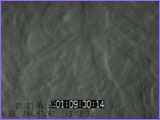
|
|
1. Early metastasis
View the clip in:
QuickTime |
RealVideo: 56K |
ISDN+
This sequence shows an early step in the spread of a cancer (a process called
metastasis). A breast cancer cell has traveled in the bloodstream and has
arrived at the liver, where it stops because it is too big to keep moving
through the tiny blood vessels to get to another organ. The cell appears bright
because it has been labeled with a fluorescent dye to help identify it.
|

|
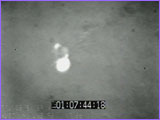
|
|
2. Escaping the bloodstream
QuickTime |
RealVideo: 56K |
ISDN+
An early step in metastasis. This cancer cell has escaped from the bloodstream
and is partly wrapped around the outside of a blood vessel. Because of this, it
does not need to attract new blood vessels at this stage.
|

|
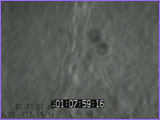
|
|
3. Cell division
QuickTime |
RealVideo: 56K |
ISDN+
The first step in the growth of a new, metastatic cancer. This cancer is made
up of two cells, which formed from the cell division of a single cell that had
escaped out of the bloodstream. It still does not need angiogenesis at this
stage, and it is growing next to a pre-existing blood vessel.
|

|
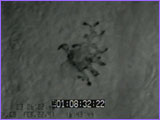
|
|
4. Small tumor
QuickTime |
RealVideo: 56K |
ISDN+
This shows a very small metastatic cancer, early in its development. This is a
melanoma tumor, so it appears black. It is growing around a blood vessel, and
you can see its three-dimensional shape as the microscope focuses up and down
through it. This small tumor still does not need to attract new blood vessels
to support its growth, because the blood vessel that it surrounds can support
its growth at this size.
|

|
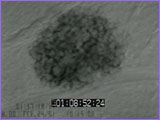
|
|
5. Attracting blood vessels
QuickTime |
RealVideo: 56K |
ISDN+
As tumors grow larger, they begin to develop the need for angiogenesis and must
attract new blood vessels if they are to keep growing. This small melanoma
cancer is beginning to show signs of blood vessel activity inside it, and these
might be 'angiogenic' new blood vessels.
|

|
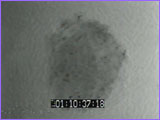
|
|
6. New blood vessels (liver)
QuickTime |
RealVideo: 56K |
ISDN+
This melanoma tumor is larger, about half a millimeter wide, or roughly the
size of a tiny grain of sand. By this stage, the tumor needs to continuously
attract new vessels to keep on growing. The normal liver tissue (lighter color)
shows normal, healthy blood flow, and the tumor (darker color) shows new,
angiogenic blood vessels with irregular shapes and blood flow, especially
visible in the higher magnification clip.
|

|

|
|
7. New blood vessels (body cavity)
QuickTime |
RealVideo: 56K |
ISDN+
This melanoma tumor, also about a half a millimeter wide, is growing on the
body cavity wall of a mouse. The black portion is the tumor and shows abnormal
'angiogenic' blood vessels, while the normal tissue (lighter color) has more
normal blood flow.
|

|
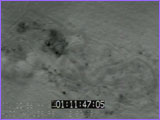
|
|
8. Continuous angiogenesis
QuickTime |
RealVideo: 56K |
ISDN+
This tumor, about a tenth of a millimeter wide and three-tenths of a millimeter
long, is also growing on the body cavity wall. It has attracted new blood
vessels to grow up to it from the normal muscle tissue below. When tumors get
to be this size, they need continuous angiogenesis to keep on growing,
otherwise their growth will stop.
|

|
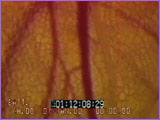
|
|
9. Normal, healthy blood vessels
QuickTime |
RealVideo: 56K |
ISDN+
This view, taken with a color video camera, shows normal, healthy blood vessels
in mouse mammary (breast) tissue. The red-filled vessels are blood vessels, and
the clear vessel (to the right of a large blood vessel) is a lymph vessel.
These blood and lymph vessels show good flow and regular branching patterns,
typical of normal, healthy organs.
|

|
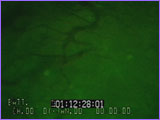
|
|
10. Angiogenic blood vessels
QuickTime |
RealVideo: 56K |
ISDN+
This view shows a breast tumor growing in mouse breast tissue. The tumor
appears green, because the cancer cells were labeled with a fluorescent dye,
and the blood vessels appear black. These are new, angiogenic vessels, and their
structure and blood flow look very irregular when compared to the regular
patterns seen in normal, healthy tissue (as in the previous clip).
|

|
Note: video clips courtesy of Dr. Ann Chambers, University of Western Ontario
Dr. Folkman Speaks |
Cancer Caught on Video
Designing Clinical Trials |
Accidental Discoveries |
How Cancer Grows
Help/Resources |
Transcript |
Site Map |
Cancer Warrior Home
Editor's Picks |
Previous Sites |
Join Us/E-mail |
TV/Web Schedule
About NOVA |
Teachers |
Site Map |
Shop |
Jobs |
Search |
To print
PBS Online |
NOVA Online |
WGBH
© | Updated February 2001
|
|
|